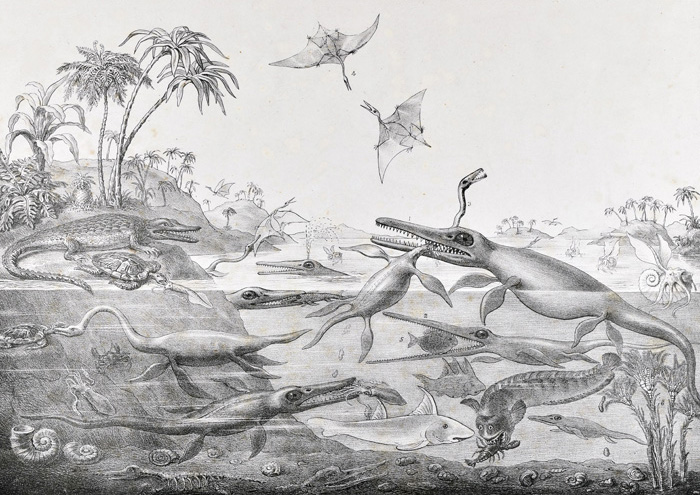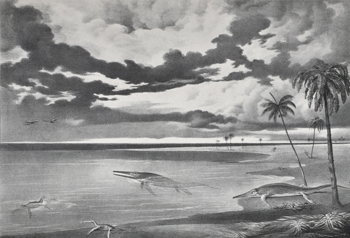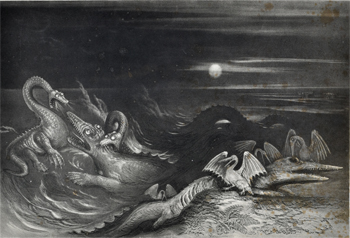Duria Antiquior, 1830

|
| 'Duria Antiquior' a reconstruction of the Jurassic life of Dorset, drawn by Henry De la Beche, lithographed by George Scharf and printed by Charles Hullmandel, [1830]. Archive ref: LDGSL/646. |
Henry De la Beche (1796-1855, GSL memb no.426) was intended for a career in the military like his father, but after being accused of encouraging ‘a dangerous spirit of Jacobinism’ amongst the other cadets, he was thrown out of the Royal Military College at Marlow in 1811. By 1812 he had moved to Lyme Regis where he met others who encouraged his interest in geology. Amongst his acquaintances were the Anning family who were just establishing their business selling fossils to tourists in the fashionable seaside resort.
As well as his early ichthyosaur studies, De la Beche is probably best known today as being the first Director of the Geological Survey (now British Geological Survey). He was, however, a gifted artist, frequently providing the illustrations for his own publications, as well as creating caricatures and cartoons for his and other's amusement.
His lithographic print Duria Antiquior, shown above, is one of the most important and influential geological images ever produced. It is the very first reconstruction of ancient life, from which all others that have followed can be traced - right through to the Jurassic Park movies. The image reconstructs Dorset during the Jurassic Period populated with the ichthyosaurs, plesiosaurs, pterosaurs, ammonites, belemnites and other creatures and plants which Mary Anning discovered. Even coprolites make an appearance, with many of the creatures, who all seem to be attacking each other in some way or other, excreting freely into the sea.

|
'Jura Formation', a reconstruction of German Jurassic life, possibly by Nicolas Christian Hohe, [1831]. The lithograph, clearly based on 'Duria Antiquior', was produced to promote the third part of Georg August Goldfuss' publication 'Petrefacta Germaniae', (1826-1844). Archive ref: LDGSL/647.
|
| |
Earning a living from fossils was precarious. As well as not being guaranteed any decent finds, prices fluctuated depending on novelty. From their height in the 1820s, fossil prices began to drop in the 1830s and 1840s. In order to help out the Anning family financially during one of the lean periods, her friends William Buckland and Henry De la Beche came up with the idea of producing the print to be sold in her aid. Duria Antiquior was first issued in or around May 1830, from an original watercolour by De la Beche. It was initially sold for the rather high price of £2 10s to the Geological Society’s Fellows, then later distributed to others. Anning was also given copies to sell in her shop.

|
|

|
| These two images, both frontispieces from Thomas Hawkins' publications on his collections, are also influenced by Duria Antiquior. The image on the left, from 'Memoirs of Ichthyosauri and Plesiosauri, extinct monsters of the ancient earth' (1834) shows a sparsely populated ancient world depicted by J S Templeton. The far more apocalyptic vision of Jurassic life by John Martin, where the ichthyosaurs are being attacked this time, is from ‘The Book of the Great Sea-Dragons, Ichthyosauri and Plesiosauri...' (1840). GSL Library collections. |
<<Back